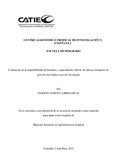Mostrar el registro sencillo del ítem
Evaluation the availability of biomass and woody regrowth capacity of pasture forage dry tropical Nicaragua
| dc.contributor.author | Lombo Ortiz, Darwin F. | |
| dc.date.accessioned | 2014-10-20T05:03:05Z | |
| dc.date.available | 2014-10-20T05:03:05Z | |
| dc.date.issued | 2012 | es_ES |
| dc.identifier | 376904 | es_ES |
| dc.identifier.uri | https://repositorio.catie.ac.cr/handle/11554/5117 | |
| dc.identifier.uri | http://orton.catie.ac.cr/repdoc/A9284e/A9284e.pdf | es_ES |
| dc.description | Tesis (M. Sc) -- CATIE, Turrialba (Costa Rica), 2012 | es_ES |
| dc.description.abstract | El propósito del presente estudio es conocer la capacidad de rebrote y los rasgos funcionales que explican la productividad de biomasa en seis especies forrajeras arbustivas en potrero del trópico seco de Nicaragua. Finalmente las especies con mayor capacidad de rebrote y Producción de biomasa se asocian con una menor AF, mientras que el AFE no fue un rasgo explicativo. Es importante mencionar que la selección de especies forrajeras arbustivas requieren de criterios más amplios donde se consideren rasgos funcionales de las plantas que mejoren la plasticidad fenotípica de las especies, por ejemplo el tamaño de la hoja, la dureza de la hoja, la relación hoja - tallo dentro de las fracciones comestibles, rasgos nutricionales de las especies como proteína cruda (PC), fibra neutro detergente (FNA), fibra acido detergente (FAD), lignina y taninos), reservas de carbohidratos en tallos, raíces finas y estructurales y finalmente los efectos de la poda en los diferentes niveles de manejo y estación climática. To contribute to the search for these resources we attempt to resprouting ability of six forage trees and shrubs and measure their functional traits associated with biomass productivity. These species were selected taking into account knowledge regarding species with the greatest potential, preference tests performed with livestock and abundance in pastures. Finally those with high coping mechanisMON to coppicing and biomass production are associated with lower LA, while the SLA was not an explanatory feature. It is worth noting that the selection of forage shrubs needs broader criteria which consider plant functional traits that enhance the phenotypic plasticity of the species, such as leaf size, leaf toughness, leaf - stem fractions in edible nutritional traits of species such as crude protein (CP), neutral detergent fiber (FNA), acid detergent fiber (ADF), lignins and tannins), carbohydrate reserves in steMON and, roots, and the structural the effects of pruning on the different levels of management and seasonal patterns. | es_ES |
| dc.language.iso | es | es_ES |
| dc.publisher | CATIE, Turrialba (Costa Rica) | es_ES |
| dc.subject | ALBIZIA SAMAN | |
| dc.subject | GLIRICIDIA SEPIUM | |
| dc.subject | PITHECELLOBIUM DULCE | |
| dc.subject | BIOMASA | |
| dc.subject | PLANTAS FORRAJERAS | |
| dc.subject | REBROTE | |
| dc.subject | TIERRAS DE PASTOREO | |
| dc.subject | NICARAGUA | |
| dc.subject | ZONA TROPICAL | |
| dc.title | Evaluation the availability of biomass and woody regrowth capacity of pasture forage dry tropical Nicaragua | es_ES |
| dc.title.alternative | Evaluación de la disponibilidad de biomasa y capacidad de rebrote de leñosas forrajeras en potreros del trópico seco de Nicaragua | es_ES |
| dc.type | Tesis de maestría | es_ES |
| dcterms.rights | acceso abierto | es_Es |
| dc.identifier.publication | Turrialba (Costa Rica) | es_ES |
Ficheros en el ítem
Este ítem aparece en la(s) siguiente(s) colección(ones)
-
Tesis [1392]


